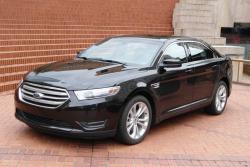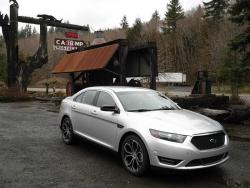 2013 Ford Taurus; photo by Paul Williams. Click image to enlarge |
|
More Ford Taurus reviews at Autos.ca
Manufacturer’s web site |
By Paul Williams
Photo Gallery:
xxx
Portland, Oregon – The big news for Ford’s big Taurus sedan is the availability of a small engine for this car in 2013. Taurus is the first car in Ford’s North American lineup to receive the four-cylinder, 2.0L, direct-injected, and turbocharged “EcoBoost” engine.
While this engine promises impressive power and fuel economy, you might think that a large car like the Taurus would be disadvantaged by a four-cylinder powerplant. But this technology — direct injection, turbocharging, high compression ratio — is a trend we’re seeing from many auto manufacturers and it’s proving to be surprisingly effective (EcoBoost, by the way, is Ford’s proprietary term for this type of technology).
In the 2013 Taurus, the 2.0 EcoBoost engine makes an estimated 240 horsepower and 270 lb-ft of torque, far exceeding the output of a Taurus V6 engine from only a few years ago. In addition to the impressive power, the 2.0L EcoBoost Taurus is expected to return excellent fuel economy.
The standard engine in the Taurus SE, SEL, and Limited models is the 288-hp 3.5L V6. All 2013 Taurus models receive now receive Ford’s six-speed SelectShift transmission.
Like the 2013 Ford Flex, the Taurus V6 receives twin independent variable camshaft timing (Ti-VCT), which reduces fuel consumption and boosts output by 10 percent. All-wheel drive is optional on the SEL model and standard on the Limited, with fuel consumption ranging from 10.7/6.9 L/100 km, city/highway for FWD versions to 11.8/7.7 L/100 km for the AWD models.
 2013 Ford Taurus; photo by Paul Williams. Click image to enlarge |
A 3.5L V6 twin-turbocharged EcoBoost engine is also available, but only in the high-performance, all-wheel-drive only SHO model, where it delivers 365 hp and 350 lb-ft of torque. Fuel consumption is estimated to be 12.2/7.8 L/100 km, city/highway.
Electronic power assisted steering (EPAS) is new for 2013, and springs and dampers have been optimized to provide better handling and ride quality across the range.
Additionally, standard Torque Vectoring Control and Curve Control help when taking corners at speed. Torque Vectoring applies subtle brake intervention to the inside wheel when cornering, moving torque to the outside wheel to maintain traction and stability. Curve Control can apply braking to the four wheels when cornering too fast, reducing speed by up to 16 km/h in one second if required. This technology can be useful on highway off and on ramps, for instance.
The 2013 Taurus is also available with a radar-based adaptive cruise control system with collision warning, Blind Spot Information System and Cross-Traffic Alert (the latter provides a warning if required when backing out of a parking space or driveway).
The 2013 Ford Taurus’ exterior design is refreshed and builds on the all-new model introduced in 2010. It features a more substantial hood, wider wheels and tires, and larger, full LED taillights.









